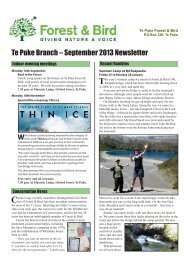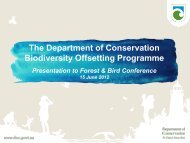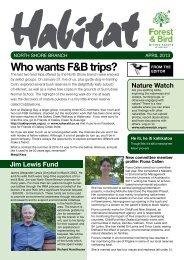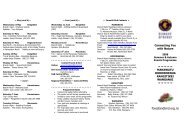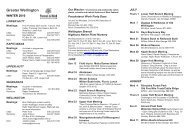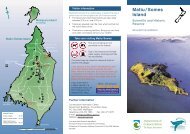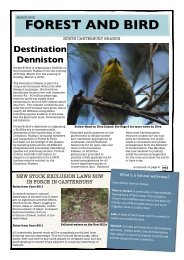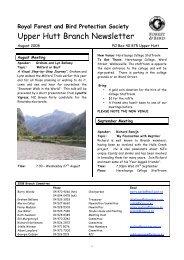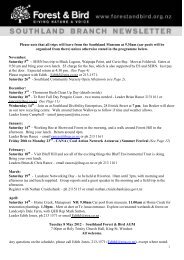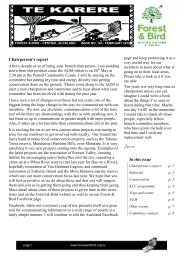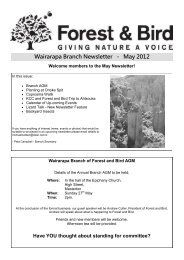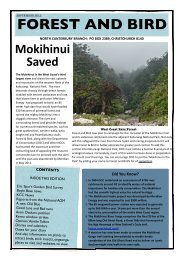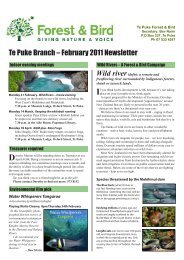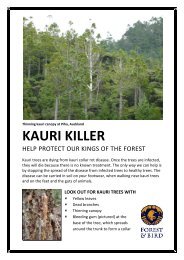May 2013 Newsletter - Forest and Bird
May 2013 Newsletter - Forest and Bird
May 2013 Newsletter - Forest and Bird
You also want an ePaper? Increase the reach of your titles
YUMPU automatically turns print PDFs into web optimized ePapers that Google loves.
<strong>May</strong> <strong>2013</strong> <strong>Newsletter</strong><br />
President: Debbie Waldin Phone 06 368 3337 Secretary: Angelina Smith Phone 06 367 3776<br />
Early Days in <strong>Forest</strong> <strong>and</strong> <strong>Bird</strong><br />
Nave <strong>Bird</strong> Protecon Society<br />
On 28 th March 1923 the inaugural meeng was held.<br />
Mr. McKenzie an ex-prime minister was elected<br />
President, <strong>and</strong> Captain Val S<strong>and</strong>erson was the Secretary.<br />
The first campaign was the eradicaon of sheep, goats<br />
<strong>and</strong> cats from Kapi Isl<strong>and</strong>. Also they published a poster<br />
“Save Our Nave <strong>Bird</strong>s” which was posted at every<br />
railway staon in New Zeal<strong>and</strong>. People traveled a lot by<br />
train in 1923. Very quickly it was realized that you<br />
couldn’t save the birds unless they had somewhere to<br />
live, so the ‘<strong>Forest</strong>” was added. There was a big<br />
campaign to plant nave trees in all school grounds. In<br />
1953 at the me of the coronaon of Queen Elizabeth,<br />
the Society was honoured with the ‘Royal’ tle, <strong>and</strong> so it<br />
has remained. Since then the Governor General,<br />
represenng the Queen, has always been the Patron of<br />
the Society.<br />
Some of our Pioneers<br />
Captain Val S<strong>and</strong>erson regarded as the founder – was<br />
first Secretary later President<br />
Sir Thomas McKenzie – 1 st President also former Prime<br />
Minister of NZ. Most famous for exploring in Fiordl<strong>and</strong>,<br />
pioneering the MilfordTrack, Lake McKenzie on the<br />
Routeburn Track named aer him.<br />
Leonard Cockayne – Founded Otari Nave Plant Museum<br />
Sir Robert Falla - Discovered the last of the takahe in<br />
Fiordl<strong>and</strong><br />
W H Guthrie-Smith - Hawkes Bay conservaonist well<br />
ahead of his me, wrote books, protected Lake Tura <strong>and</strong><br />
founded the Outdoor Pursuits Centre.<br />
Perrin Moncrief – instrumental in formaon of Abel<br />
Tasman Naonal Park. She was called the bloomer lady<br />
because she wore shorts.<br />
John T Salmon – published the “Nave Plants of NZ”.<br />
Norm Dalmuir – from Levin, Naonal Treasurer for many<br />
years.<br />
Charles Fleming – famous naturalist, birds <strong>and</strong> plants,<br />
lived by Waikanae Estuary.<br />
Audrey Eagle – botanist <strong>and</strong> painter, author “Eagle’s<br />
Trees <strong>and</strong> Shrubs”.<br />
All these people won the Loder Cup, which is sll awarded<br />
every year to outst<strong>and</strong>ing conservaonists, <strong>and</strong> they were<br />
on the Execuve of <strong>Forest</strong> & <strong>Bird</strong> at one me.<br />
The Coming-of-age of Conservaon<br />
In the 1970’s there was a big campaign to stop the<br />
Government raising the level of Lake Manapouri. This<br />
really caused people to become aware of the need for<br />
conservaon <strong>and</strong> protecon of our special places. A<br />
peon of over 250,000 was presented to the<br />
Government asking not to raise the level of the lake, <strong>and</strong><br />
<strong>Forest</strong> & <strong>Bird</strong>’s membership grew at that me in leaps<br />
<strong>and</strong> bounds.<br />
In the 1980’s a new era began. A new Conservaon<br />
Officer was appointed <strong>and</strong> the campaigns began. Logging<br />
of nave trees was stopped; chipping of beech logs was<br />
stopped; the Dept of Conservaon was formed; the<br />
Resource Management Act was passed, <strong>and</strong> a World<br />
Heritage area was declared in South Westl<strong>and</strong>, all within<br />
a few years. Joan Leckie
Reading the History of the Otaki<br />
Gorge through the Vegetation<br />
Ian Cooksley, our local DOC representative <strong>and</strong> a<br />
foundation member of the Horowhenua Branch, led<br />
this March trip along the Gorge Road as far as the<br />
Gorge. We shared transport <strong>and</strong> stopped at 8 key<br />
sites along the way to view the vegetation that<br />
gives clues to past activities.<br />
Our first stop was at the Totara Tunnel Reserve,<br />
where there is a remnant st<strong>and</strong> of Totara hugging<br />
the fenceline, each tree surrounded by rocks.<br />
These trees are treasured by nearby residents as<br />
well as the so called ‘consumption’ stone walls made<br />
by relief workers during the depression years to<br />
use up the hundreds of stones that covered the<br />
paddocks.<br />
Next stop was Waihoanga just by the present<br />
swing bridge leading over to the settlement. The<br />
Lawsons cypress here were planted for shelter <strong>and</strong><br />
just before the bridge at the Mansells homestead<br />
a Gingko <strong>and</strong> Redwoods were planted. This was the<br />
site of a flourishing settlement in the 1930s <strong>and</strong><br />
Andrea Hirschberg, who came with us on the trip,<br />
told us that there are once again 40 residents<br />
living over the bridge.<br />
Onto the water ford, or “the splash” as the locals<br />
call it. Near to the former site of the Isbister Mill<br />
on the terrace above the road is a grove of<br />
eucalypt trees planted as an alternative to milling<br />
pine. The tramline leading to the mill ran for 4 kms<br />
around the face. The local council offered to<br />
bridge the ford but local pressure ensured that it<br />
was retained.<br />
Shield’s Flat was our next stop. Here there is a<br />
platform with a large information board telling of<br />
the history of this area. A pig farmer, Paddy<br />
Shields, wife <strong>and</strong> 10 children settled near to here<br />
during the depression years <strong>and</strong> the stone walls<br />
were made as pig pens by the relief workers. A lone<br />
spreading fig tree, planted many years ago, st<strong>and</strong>s<br />
alongside the road.<br />
The Monument by the roadside was our next stop<br />
with the great view of all the streams <strong>and</strong> rivers<br />
meeting to become the Otaki Forks. Again there is<br />
still a shelter belt of Lawsons cypress <strong>and</strong> just<br />
across the road, there is still evidence of the<br />
school, P.O. <strong>and</strong> orphanage, as well as the remains<br />
of a variety of herbaceous shrubs in the clearing.<br />
Ian pointed out an interesting shrub on the side of<br />
the road that has leaves that smell of peanut<br />
butter when crushed.<br />
Further along the road at the overnight parking<br />
area there are many hydrangeas <strong>and</strong> herbaceous<br />
shrubs bordering the parking bays <strong>and</strong> Ian pointed<br />
out a South American Beech tree planted as a trial<br />
for future logging.<br />
Our final stop of the day was School House Flat<br />
where, to our surprise, the huge pine trees planted<br />
by the Arcus’s have just been removed- they were<br />
deemed to be a danger to the many campers that<br />
enjoy this site over the summer months. Hazelnut<br />
trees mark a former orchard <strong>and</strong> the single Miro<br />
tree on the grass was in the garden.<br />
Thanks for taking the time to share this history<br />
with us Ian <strong>and</strong> we do hope that you will get time<br />
to write it all down for future reference.<br />
Margarette
“GODWITS OF THE MANAWATU ESTUARY”<br />
Our March speaker was Jimmy Choi <strong>and</strong> he gave us a<br />
fascinating talk on this subject. We all thought we knew<br />
a great deal, but Jimmy was able to tell us much more,<br />
as he has just completed his PH.D at Massey University<br />
on Godwits <strong>and</strong> has even spent time in China doing the<br />
field work.<br />
There are 5 sub-species <strong>and</strong> the male godwit is smaller<br />
<strong>and</strong> darker in colour with a slightly shorter beak. They<br />
have a very strong gizzard <strong>and</strong> feed on worms, shrimps<br />
<strong>and</strong> shellfish swallowing these shells <strong>and</strong> all.<br />
Centuries ago people thought that they buried<br />
themselves in the mud when they disappeared but we<br />
now know of their migration patterns.<br />
<strong>Bird</strong>s are caught in a variety of nets in order to b<strong>and</strong><br />
them <strong>and</strong> attach tracking devices to study them. Each<br />
colour b<strong>and</strong> indicates a certain study area <strong>and</strong> it has<br />
been found that they return to exactly the same place<br />
each year. They appear to have an internal calendar,<br />
follow exactly the same route but also watch the<br />
Trip to Pohangina 6 April <strong>2013</strong><br />
The weather was lovely in Levin, but not quite as good in<br />
Pohangina. However, an enthusiastic group of fifteen<br />
walked the Pohangina Wetl<strong>and</strong> run by a trust started by<br />
Gordon <strong>and</strong> Anne Pilone. A well maintained wetl<strong>and</strong>, not<br />
many birds about but we did see a pair of black fronted<br />
dotterel <strong>and</strong> a grey teal It started to rain towards the<br />
end so we retreated to Lutterell’s who had offered us an<br />
undercover place to have our lunch. This was great <strong>and</strong><br />
after we had eaten the rain cleared <strong>and</strong> we were able to<br />
walk around the bush <strong>and</strong> wetl<strong>and</strong> here which is on the<br />
opposite side of the road to the Pohangina Wetl<strong>and</strong>.<br />
Luttrell’s have a very interesting museum which we also<br />
visited. We finished with Devonshire tea at the Country<br />
Fayre Café. Lena<br />
weather <strong>and</strong> can leave slightly earlier if a storm is<br />
brewing or later to avoid unfavourable conditions.<br />
While in NZ they moult, grow strong new feathers in<br />
preparation, stock up on food in readiness <strong>and</strong> are able<br />
to shrink their internal organs to make them sleeker<br />
<strong>and</strong> lighter for the marathon flight. They fly non-stop<br />
to China, some 10.000Kms, stop over to feed <strong>and</strong> rest<br />
then on another 6500Kms to Alaska where they breed.<br />
One of the problems now facing our remarkable godwit<br />
population is that the stop over spots in Korea are<br />
being reclaimed as fish breeding ponds <strong>and</strong> so without<br />
these stop over feeding/rest sites, there has been<br />
quite a decline in the numbers of godwits over the last<br />
period of years.<br />
A very special night for all present. We were all<br />
impressed by Jimmy’s enthusiasm <strong>and</strong> detailed<br />
knowledge of this topic. Margarette<br />
Margarette<br />
Some of the group at Luttrell’s Tim Luttrell front right<br />
Pohangina Wetl<strong>and</strong> 2000 <strong>and</strong> 2012
DID YOU KNOW?<br />
The Australasian Gannet<br />
Takapu<br />
This bird provides one of the most<br />
dramatic sights around the NZ coast as it<br />
plunges into the sea at high speed for fish.<br />
They drop from heights as great as 30<br />
metres , at speeds of up to 145kms <strong>and</strong><br />
tuck their wings in close to their body as<br />
they slice into the water. Long narrow<br />
wings, like those of the gannet, are built<br />
for gliding <strong>and</strong> soaring on the air currents<br />
created around cliff faces.<br />
There are three accessible mainl<strong>and</strong> colonies in<br />
NZ - Cape Kidnappers in Hawkes Bay, Muriwai,<br />
a West Auckl<strong>and</strong> beach, <strong>and</strong> the closest to us across<br />
the water is Farewell Spit where 900 pairs nest.<br />
Return Address<br />
Horowhenua <strong>Forest</strong> &<br />
<strong>Bird</strong><br />
C/- L. Berger<br />
5 Gordon Place<br />
LEVIN<br />
Curlew at Ohau Estuary<br />
Photo by Lena Berger<br />
HELP NEEDED<br />
For many years Naomi has been our very<br />
efficient treasurer <strong>and</strong> now that she is<br />
approaching 90years old she would like<br />
someone to understudy her in this role with<br />
the view to taking over the job in 2014.<br />
There is a computer programme to enter all<br />
the finances so all that is needed is a<br />
computer, <strong>and</strong> some skill in operating this<br />
programme.<br />
Naomi would give you all the help needed to get<br />
up to speed.<br />
Any volunteers?<br />
Talk to Naomi or any committee member about<br />
it if you’re interested.<br />
NZ is considered to be one of<br />
the best places to<br />
view gannets.<br />
We would like to thank the Eastern &<br />
Central Community Trust for their grant<br />
which is enabling us to produce our<br />
newsletter in colour.<br />
A Tribute to Pauline Jackson<br />
In February we were saddened by the passing of one of<br />
our keen members Pauline, after a courageous battle with<br />
cancer over the last 4 years.<br />
Pauline was a keen observer of nature , loved the<br />
outdoors, <strong>and</strong> came on many of our tramps. Before the<br />
onset of her illness she was very fit <strong>and</strong> loved scrambling<br />
over rough terrain. She will be greatly missed by our<br />
organisation <strong>and</strong> by all who were fortunate to know her.<br />
You were an inspiration Pauline.



